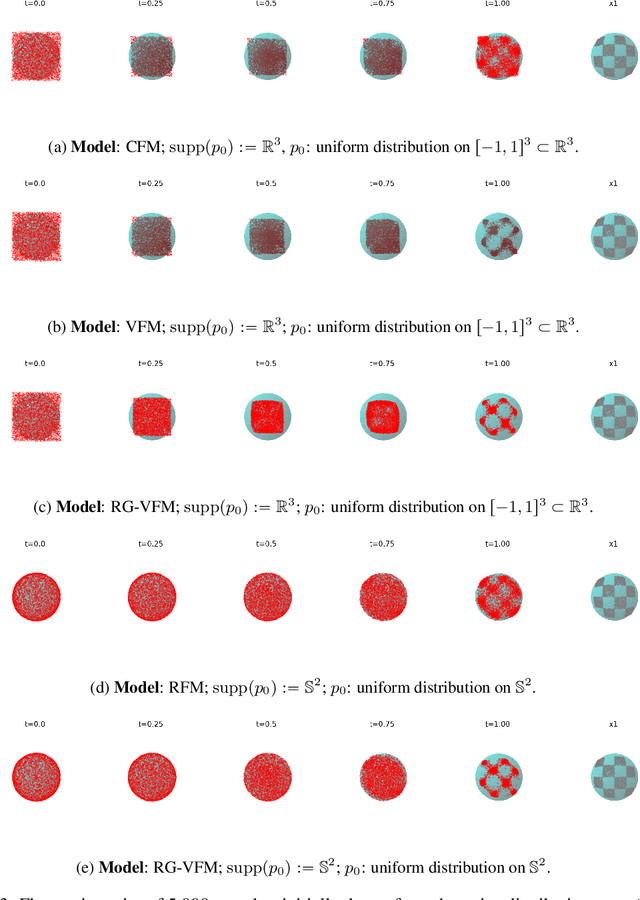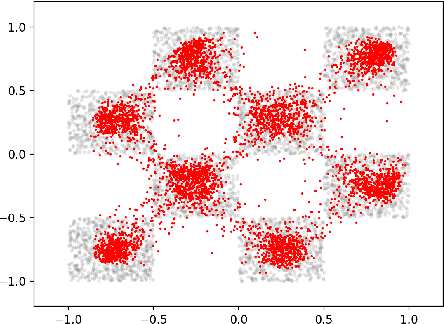Floor Eijkelboom
University of Amsterdam
Purrception: Variational Flow Matching for Vector-Quantized Image Generation
Oct 01, 2025Abstract:We introduce Purrception, a variational flow matching approach for vector-quantized image generation that provides explicit categorical supervision while maintaining continuous transport dynamics. Our method adapts Variational Flow Matching to vector-quantized latents by learning categorical posteriors over codebook indices while computing velocity fields in the continuous embedding space. This combines the geometric awareness of continuous methods with the discrete supervision of categorical approaches, enabling uncertainty quantification over plausible codes and temperature-controlled generation. We evaluate Purrception on ImageNet-1k 256x256 generation. Training converges faster than both continuous flow matching and discrete flow matching baselines while achieving competitive FID scores with state-of-the-art models. This demonstrates that Variational Flow Matching can effectively bridge continuous transport and discrete supervision for improved training efficiency in image generation.
Exponential Family Variational Flow Matching for Tabular Data Generation
Jun 06, 2025



Abstract:While denoising diffusion and flow matching have driven major advances in generative modeling, their application to tabular data remains limited, despite its ubiquity in real-world applications. To this end, we develop TabbyFlow, a variational Flow Matching (VFM) method for tabular data generation. To apply VFM to data with mixed continuous and discrete features, we introduce Exponential Family Variational Flow Matching (EF-VFM), which represents heterogeneous data types using a general exponential family distribution. We hereby obtain an efficient, data-driven objective based on moment matching, enabling principled learning of probability paths over mixed continuous and discrete variables. We also establish a connection between variational flow matching and generalized flow matching objectives based on Bregman divergences. Evaluation on tabular data benchmarks demonstrates state-of-the-art performance compared to baselines.
Towards Variational Flow Matching on General Geometries
Feb 18, 2025



Abstract:We introduce Riemannian Gaussian Variational Flow Matching (RG-VFM), an extension of Variational Flow Matching (VFM) that leverages Riemannian Gaussian distributions for generative modeling on structured manifolds. We derive a variational objective for probability flows on manifolds with closed-form geodesics, making RG-VFM comparable - though fundamentally different to Riemannian Flow Matching (RFM) in this geometric setting. Experiments on a checkerboard dataset wrapped on the sphere demonstrate that RG-VFM captures geometric structure more effectively than Euclidean VFM and baseline methods, establishing it as a robust framework for manifold-aware generative modeling.
Variational Flow Matching for Graph Generation
Jun 07, 2024Abstract:We present a formulation of flow matching as variational inference, which we refer to as variational flow matching (VFM). Based on this formulation we develop CatFlow, a flow matching method for categorical data. CatFlow is easy to implement, computationally efficient, and achieves strong results on graph generation tasks. In VFM, the objective is to approximate the posterior probability path, which is a distribution over possible end points of a trajectory. We show that VFM admits both the CatFlow objective and the original flow matching objective as special cases. We also relate VFM to score-based models, in which the dynamics are stochastic rather than deterministic, and derive a bound on the model likelihood based on a reweighted VFM objective. We evaluate CatFlow on one abstract graph generation task and two molecular generation tasks. In all cases, CatFlow exceeds or matches performance of the current state-of-the-art models.
E(n) Equivariant Message Passing Cellular Networks
Jun 06, 2024



Abstract:This paper introduces E(n) Equivariant Message Passing Cellular Networks (EMPCNs), an extension of E(n) Equivariant Graph Neural Networks to CW-complexes. Our approach addresses two aspects of geometric message passing networks: 1) enhancing their expressiveness by incorporating arbitrary cells, and 2) achieving this in a computationally efficient way with a decoupled EMPCNs technique. We demonstrate that EMPCNs achieve close to state-of-the-art performance on multiple tasks without the need for steerability, including many-body predictions and motion capture. Moreover, ablation studies confirm that decoupled EMPCNs exhibit stronger generalization capabilities than their non-topologically informed counterparts. These findings show that EMPCNs can be used as a scalable and expressive framework for higher-order message passing in geometric and topological graphs
Clifford Group Equivariant Simplicial Message Passing Networks
Feb 20, 2024



Abstract:We introduce Clifford Group Equivariant Simplicial Message Passing Networks, a method for steerable E(n)-equivariant message passing on simplicial complexes. Our method integrates the expressivity of Clifford group-equivariant layers with simplicial message passing, which is topologically more intricate than regular graph message passing. Clifford algebras include higher-order objects such as bivectors and trivectors, which express geometric features (e.g., areas, volumes) derived from vectors. Using this knowledge, we represent simplex features through geometric products of their vertices. To achieve efficient simplicial message passing, we share the parameters of the message network across different dimensions. Additionally, we restrict the final message to an aggregation of the incoming messages from different dimensions, leading to what we term shared simplicial message passing. Experimental results show that our method is able to outperform both equivariant and simplicial graph neural networks on a variety of geometric tasks.
Can strong structural encoding reduce the importance of Message Passing?
Oct 22, 2023Abstract:The most prevalent class of neural networks operating on graphs are message passing neural networks (MPNNs), in which the representation of a node is updated iteratively by aggregating information in the 1-hop neighborhood. Since this paradigm for computing node embeddings may prevent the model from learning coarse topological structures, the initial features are often augmented with structural information of the graph, typically in the form of Laplacian eigenvectors or Random Walk transition probabilities. In this work, we explore the contribution of message passing when strong structural encodings are provided. We introduce a novel way of modeling the interaction between feature and structural information based on their tensor product rather than the standard concatenation. The choice of interaction is compared in common scenarios and in settings where the capacity of the message-passing layer is severely reduced and ultimately the message-passing phase is removed altogether. Our results indicate that using tensor-based encodings is always at least on par with the concatenation-based encoding and that it makes the model much more robust when the message passing layers are removed, on some tasks incurring almost no drop in performance. This suggests that the importance of message passing is limited when the model can construct strong structural encodings.
$\mathrm{E}(n)$ Equivariant Message Passing Simplicial Networks
May 11, 2023Abstract:This paper presents $\mathrm{E}(n)$ Equivariant Message Passing Simplicial Networks (EMPSNs), a novel approach to learning on geometric graphs and point clouds that is equivariant to rotations, translations, and reflections. EMPSNs can learn high-dimensional simplex features in graphs (e.g. triangles), and use the increase of geometric information of higher-dimensional simplices in an $\mathrm{E}(n)$ equivariant fashion. EMPSNs simultaneously generalize $\mathrm{E}(n)$ Equivariant Graph Neural Networks to a topologically more elaborate counterpart and provide an approach for including geometric information in Message Passing Simplicial Networks. The results indicate that EMPSNs can leverage the benefits of both approaches, leading to a general increase in performance when compared to either method. Furthermore, the results suggest that incorporating geometric information serves as an effective measure against over-smoothing in message passing networks, especially when operating on high-dimensional simplicial structures. Last, we show that EMPSNs are on par with state-of-the-art approaches for learning on geometric graphs.
 Add to Chrome
Add to Chrome Add to Firefox
Add to Firefox Add to Edge
Add to Edge